20 Essential Tips for Email Marketing Success
Hit your Financial Freedom Goal with these Email Marketing Success eCourses!
If your goal is to achieve a remarkable $60,000 within just four weeks, then this course is the exact roadmap you've been seeking:
If you're on the lookout for an uncomplicated yet highly effective method to capitalize on your email list, look no further than this course:
Introduction
Email marketing is a powerful tool that allows businesses to reach a large audience quickly and efficiently. To maximize the potential of this marketing method, it is crucial to follow best practices and employ effective strategies. In this blog post, we will share 20 valuable tips for email marketing success that can help you engage your audience, drive conversions, and build lasting relationships with your subscribers.

Start by building your email list organically, asking for explicit permission from individuals before adding them to your list. This ensures that your subscribers genuinely want to receive your emails, leading to higher engagement rates.
In today's digital age, building an email list has become a fundamental aspect of successful marketing strategies. However, the key to creating a valuable and engaged audience lies in building your email list organically.
Instead of resorting to aggressive tactics or purchasing lists, take the ethical route by seeking explicit permission from individuals before adding them to your list.
When you ask for explicit permission, you're respecting your potential subscribers' preferences and privacy. This approach ensures that your email recipients genuinely want to receive your emails, resulting in higher engagement rates.
By having a list of subscribers who are genuinely interested in your content, you increase the chances of your emails being opened, read, and acted upon.
Organic list-building also fosters trust and credibility between you and your audience.
When people willingly join your email list, they perceive your brand as respectful and trustworthy, which goes a long way in building lasting relationships. So, take the time to nurture your email list organically, and remember that quality always triumphs over quantity.
Engage with your subscribers genuinely and provide them with valuable content, and you'll witness the growth of a loyal and enthusiastic audience eager to receive your emails.
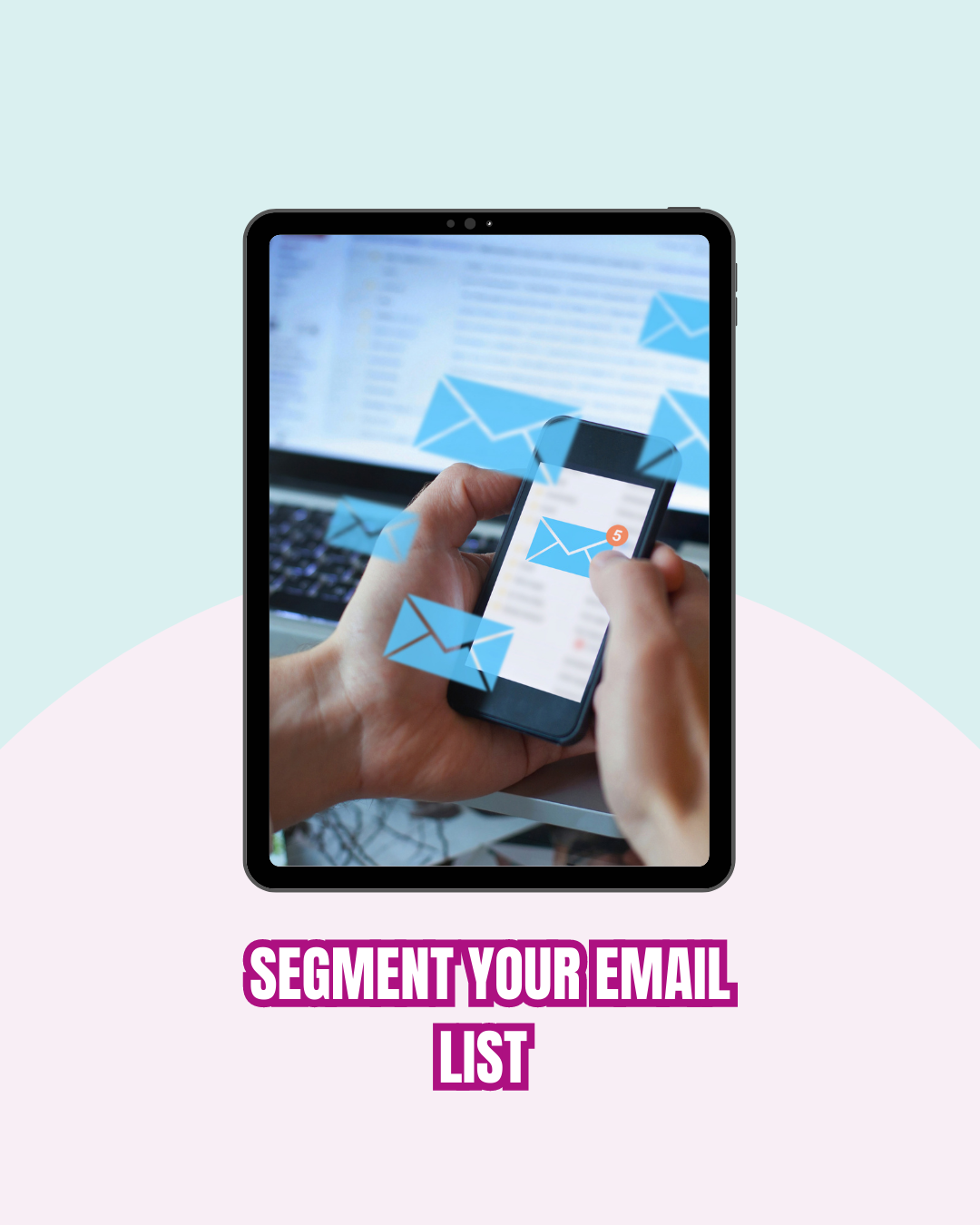
Segmenting your email list based on demographics, interests, or behavior allows you to send targeted and relevant content, increasing the chances of your emails resonating with recipients. Segmenting your email list is a powerful strategy
that can significantly enhance the effectiveness of your email marketing campaigns. By dividing your subscribers based on demographics, interests, or behavior, you gain the ability to send highly targeted
and relevant content to each segment.
Understanding your audience's preferences and needs enables you to tailor your messages specifically to their interests. For example, you can create personalized emails
that speak directly to the unique challenges and desires of each group. This level of customization increases the chances of your emails resonating with recipients, leading to higher open rates, click-through rates, and overall engagement.
Moreover, segmentation allows you to avoid bombarding your entire list with emails that may not be relevant to everyone. Instead, you can send content that truly matters to each group, which not only boosts engagement but also reduces the
risk of unsubscribes or disengagement.
As your email list grows and your audience diversifies, segmentation becomes even more critical. It enables you to maintain a strong connection with each segment,
fostering a sense of trust and loyalty. By showing that you genuinely understand and cater to their specific interests and preferences, you demonstrate your commitment to providing value, which, in turn, strengthens your brand's reputation.
In conclusion, segmenting your email list is a smart and efficient way to maximize the impact of your email marketing efforts. By sending targeted content that resonates with your subscribers,
you'll experience higher engagement rates and build stronger, more meaningful relationships with your audience.
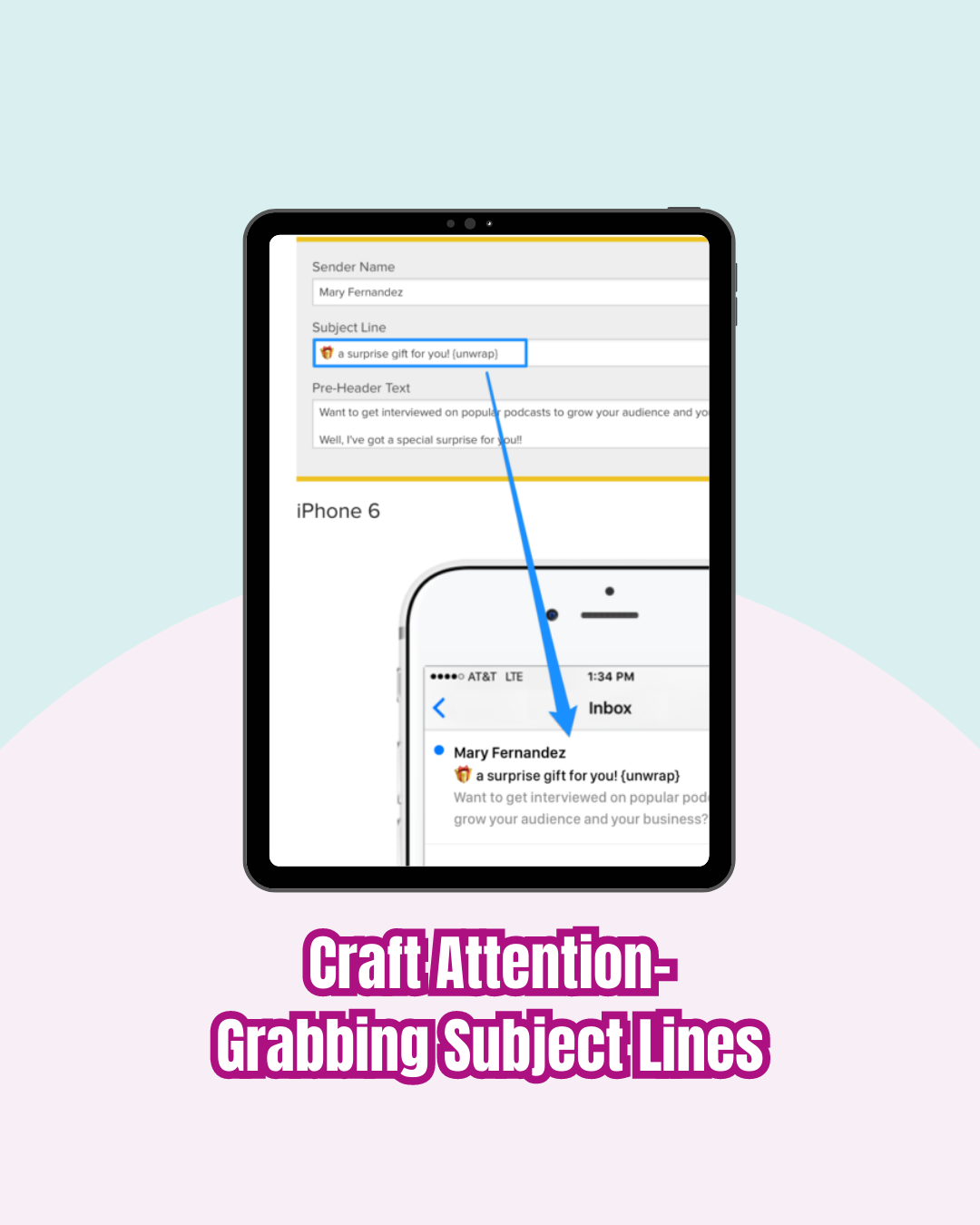
Grab your subscribers' attention with concise and compelling subject lines. A well-crafted subject line entices recipients to open your email and discover what you have to offer. In the world of email marketing,
a captivating subject line can make all the difference. Crafting attention-grabbing subject lines is an art that can significantly boost your email open rates. Think of the subject line as your email's first impression
– it's what entices recipients to click and explore what lies within.
To create a subject line that stands out, keep it concise yet compelling. Avoid being too vague or overly promotional, as it may lead to your email being marked as spam.
Instead, focus on creating a sense of curiosity or urgency, and consider incorporating personalization to make it more relevant to your audience. Experiment with different techniques, such as posing a question,
teasing valuable content, or offering an exclusive deal. A touch of creativity and wit can go a long way in capturing your subscribers' attention amidst the sea of emails in their inbox. Remember that honesty is crucial;
your subject line should accurately reflect the content of your email. Delivering on your subject line's promise builds trust with your audience and encourages repeat engagement.In conclusion, a well-crafted subject line is a powerful tool
in your email marketing arsenal. By piquing your subscribers' curiosity and delivering value, you increase the likelihood of them opening your emails and taking action, ultimately leading to a more successful email campaign.

Make your emails feel more personal by addressing subscribers by their names and tailoring the content to their preferences. Personalization enhances the connection between your brand and your audience.
In the fast-paced digital world, personalization has become a key element in effective email marketing. Gone are the days of generic one-size-fits-all emails. To establish a genuine and lasting connection with your audience,
it's essential to personalize your emails.
Addressing subscribers by their names is a simple yet powerful way to create a more intimate and engaging experience. It shows that you value each individual
as a unique member of your community, not just another email address on your list.
But personalization goes beyond just using a name. Tailoring the content to match your subscribers' preferences and interests makes them
feel seen and understood. By analyzing their past interactions with your emails and website, you can segment your audience and send targeted content that speaks directly to their needs and desires.
Personalization is not just about inserting names and using advanced technology. It's about crafting messages that resonate with your subscribers on a personal level. Show empathy, offer relevant recommendations,
and be genuinely helpful. When your subscribers feel that your emails are tailored specifically for them, they are more likely to engage, click through, and take action.
Ultimately, personalization enhances
the connection between your brand and your audience. It builds trust and loyalty, which are invaluable assets in today's competitive landscape. So, embrace the power of personalization and watch as
your email campaigns flourish with higher open rates, increased click-throughs, and a devoted community of engaged subscribers.
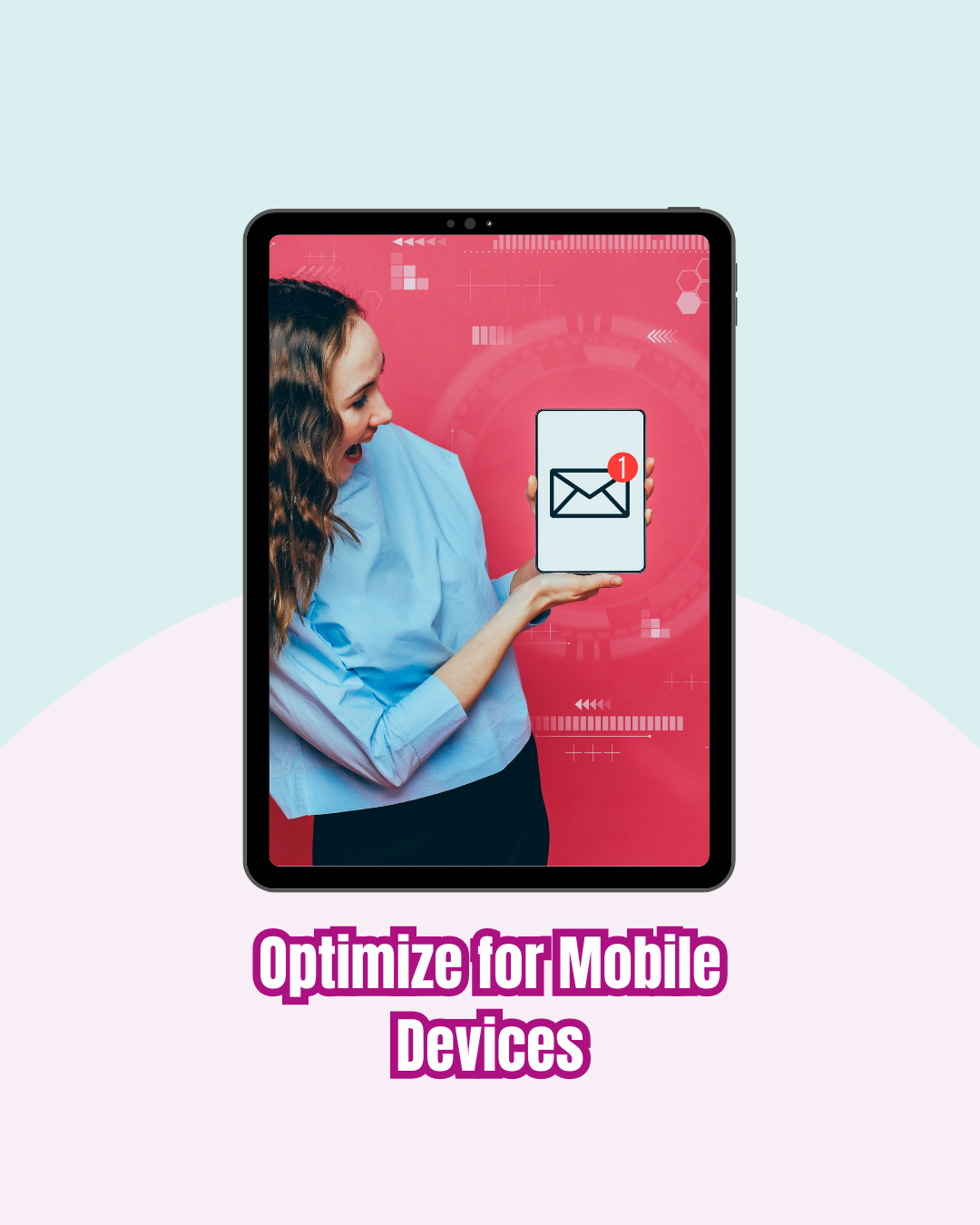
With the majority of people checking emails on their mobile devices, ensure your emails are mobile-friendly and easy to navigate on smaller screens. In the era of mobile technology, optimizing your emails
for mobile devices is no longer an option; it's a necessity. With the majority of people now checking their emails on smartphones and tablets, failing to make your emails mobile-friendly can result in missed opportunities and reduced engagement.
When crafting your emails, keep in mind the smaller screens and varying resolutions of mobile devices. Ensure that your email templates are responsive, adapting seamlessly to different screen sizes. This way, your subscribers will have
a comfortable and enjoyable reading experience, regardless of the device they use.
Keep your content concise and easy to scan, as mobile users often have limited time and attention spans. Use clear and compelling calls-to-action
that are easily clickable on touchscreens, encouraging seamless navigation and interaction.
Testing your emails on various mobile devices and email clients is essential to spot any formatting issues and ensure that your message
appears as intended. This attention to detail reflects your commitment to providing a smooth and user-friendly experience, which, in turn, strengthens your brand image and customer satisfaction. Optimizing for mobile devices
not only enhances user experience but also positively impacts your email performance. Mobile-friendly emails are more likely to be opened, read, and acted upon, leading to higher click-through rates and conversion rates. In conclusion, with the prevalence of
optimizing your emails for mobile devices is an indispensable aspect of modern email marketing. By providing a seamless and enjoyable experience for mobile users, you ensure that your messages reach and resonate
with your audience, contributing to the overall success of your email campaigns.
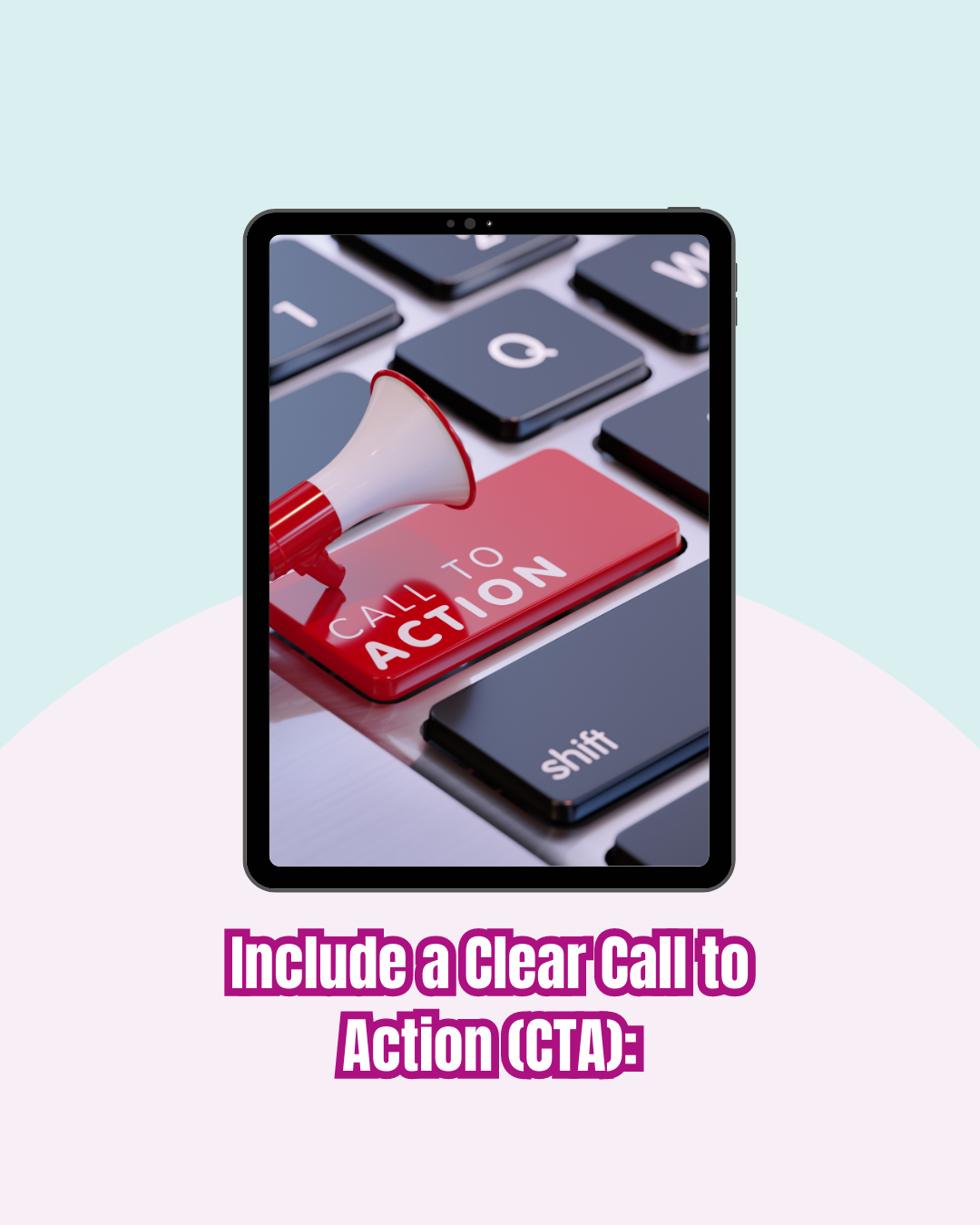
Every email should have a clear and compelling call to action that guides subscribers to take the desired action, whether it's making a purchase, signing up for an event, or downloading a resource.
A compelling call to action (CTA) is the driving force behind a successful email campaign. It's the catalyst that encourages your subscribers to take the desired action, whether that's making a purchase, signing up for an event,
or downloading a resource. Without a clear CTA, your email may lack direction and fail to achieve its intended goals.
When crafting your CTA, be direct and specific about what you want your subscribers to do.
Use action-oriented language that instills a sense of urgency or excitement. For example, phrases like "Shop Now," "Register Today," or "Get Your Free Guide" can be highly effective in motivating your audience to act promptly.
Ensure that your CTA
stands out visually. Use contrasting colors, bold fonts, or buttons to make it easily noticeable and clickable. The placement of your CTA is equally crucial – it should be prominently positioned, ideally above the fold, so subscribers don't have
to scroll to find it.
Personalization can further enhance the effectiveness of your CTA. If you have segmented your email list based on user preferences, tailor your CTAs accordingly. For instance, use different CTAs for new subscribers versus
loyal customers, providing relevant offers that cater to each group's interests.
Regularly test different CTAs to see which ones generate the best results. A/B testing allows you to compare different variations of your CTA to determine what
resonates most with your audience. Use these insights to refine your future email campaigns continually.
In conclusion, a clear and compelling call to action is a vital component of every email you send. It directs your subscribers to take action,
turning them from passive readers into engaged participants. By being direct, visually prominent, and personalized, your CTA can significantly impact your email's success, driving conversions and fostering a deeper connection with your audience.
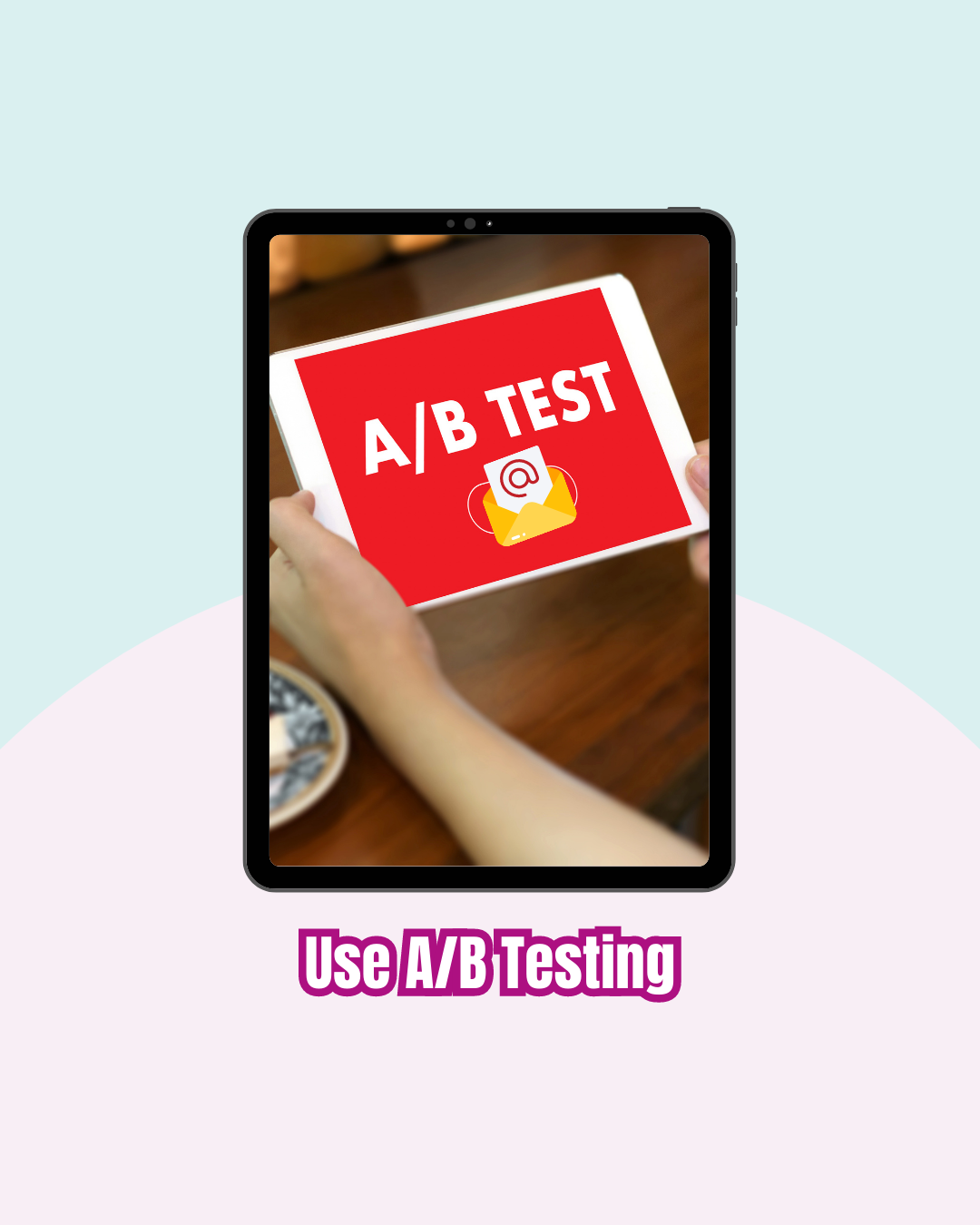
Experiment with A/B testing to determine the most effective elements of your emails, such as subject lines, CTAs, visuals, or email layouts.
A/B testing, also known as split testing,
is a powerful tool that can revolutionize your email marketing strategy. It allows you to experiment with different elements of your emails to identify the most effective variations that resonate with your audience.
Subject lines play a crucial role in enticing subscribers to open your emails. With A/B testing, you can test multiple subject lines and analyze which ones yield higher open rates. Whether it's testing different tones,
lengths, or personalization, this valuable insight helps you refine your subject lines for maximum impact.
The call to action (CTA) is the driving force behind conversions. By A/B testing various CTAs,
you can pinpoint the language, design, and placement that drives the most clicks and conversions. Whether it's changing the wording or button color, this data-driven approach enables you to optimize your CTAs for better results.
Visuals and email layouts can significantly impact engagement. Test different email designs, images, and layouts to discover which ones resonate best with your audience. You might find that a simple and clean
layout performs better than a more elaborate one or that specific visuals evoke a stronger response.
To conduct A/B tests effectively, focus on testing one variable at a time to ensure clear and accurate results.
Split your email list into two groups, each receiving a different version, and then measure the performance metrics for comparison.
By harnessing the power of A/B testing, you can continually refine and improve your email campaigns.
Data-driven decisions based on real subscriber feedback enable you to create emails that truly connect with your audience, leading to higher engagement, increased conversions, and overall marketing success.
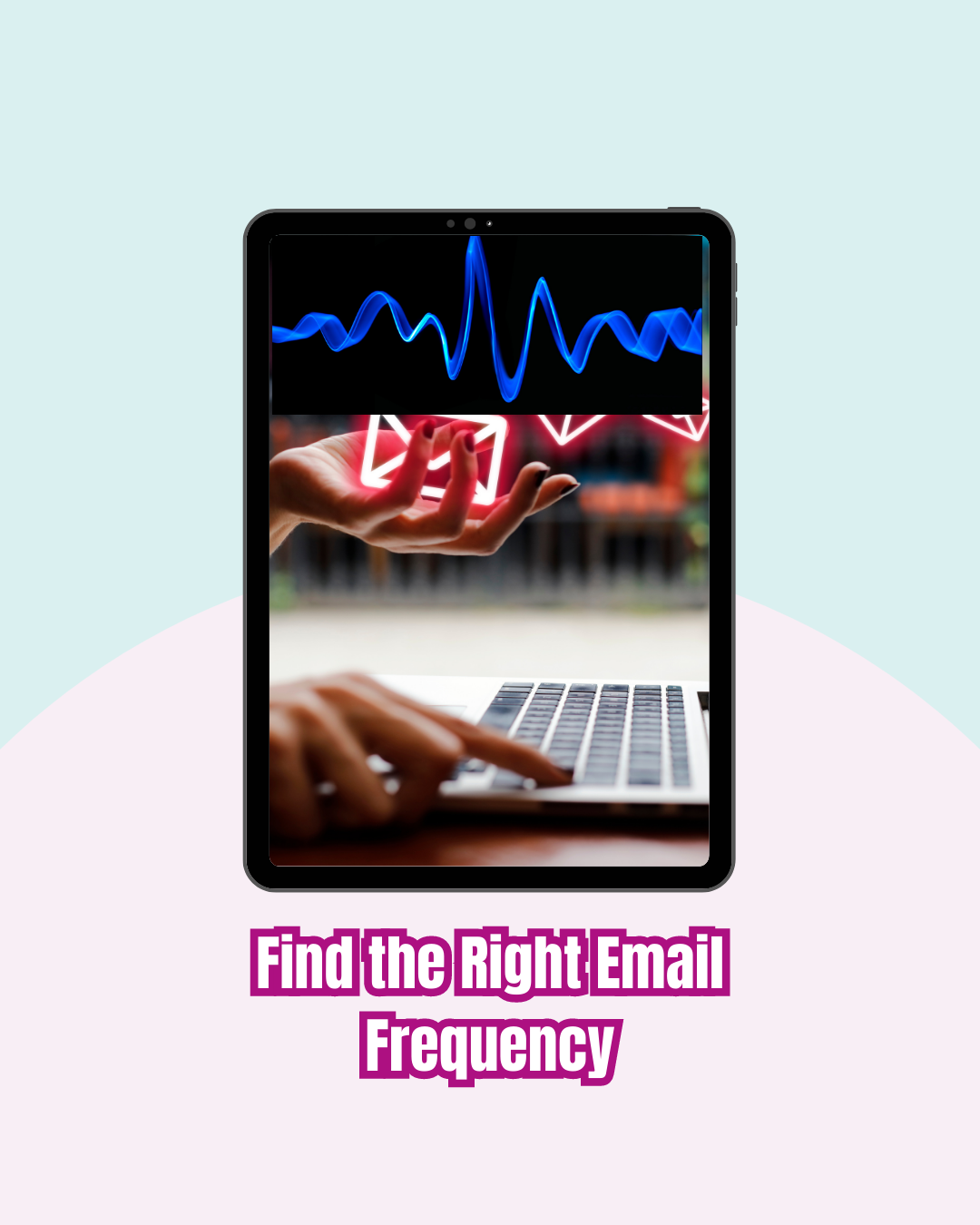
Strike a balance with your email frequency. Avoid bombarding your subscribers with too many emails while ensuring you maintain regular communication.
Finding the right email frequency is a delicate balancing act in email marketing.
On one hand, you want to stay top-of-mind with your subscribers and maintain regular communication. On the other hand, bombarding them with too many emails can lead to fatigue and unsubscribes.
The key to striking the right balance lies in understanding your audience and their preferences. Conduct surveys or analyze engagement data to determine the optimal email frequency for your specific audience segment.
ome subscribers may prefer frequent updates, while others may prefer a more spaced-out approach.
Segmenting your email list based on engagement levels can also help tailor the frequency to each group's preferences.
Engaged subscribers may appreciate more frequent communication, while less active ones might benefit from a less intrusive approach.
Quality should always trump quantity when it comes to email frequency.
Focus on providing valuable content and personalized offers rather than flooding inboxes with irrelevant messages. High-quality emails are more likely to be welcomed and read, leading to better overall engagement.
Lastly, don't be afraid to ask your subscribers for feedback directly. A simple preference center or feedback survey can help you gauge their satisfaction with your email frequency and
make adjustments accordingly. In conclusion, finding the right email frequency is about understanding your audience, respecting their preferences, and delivering value. By striking the right balance,
you can maintain regular communication without overwhelming your subscribers, ultimately fostering a stronger and more loyal email community.
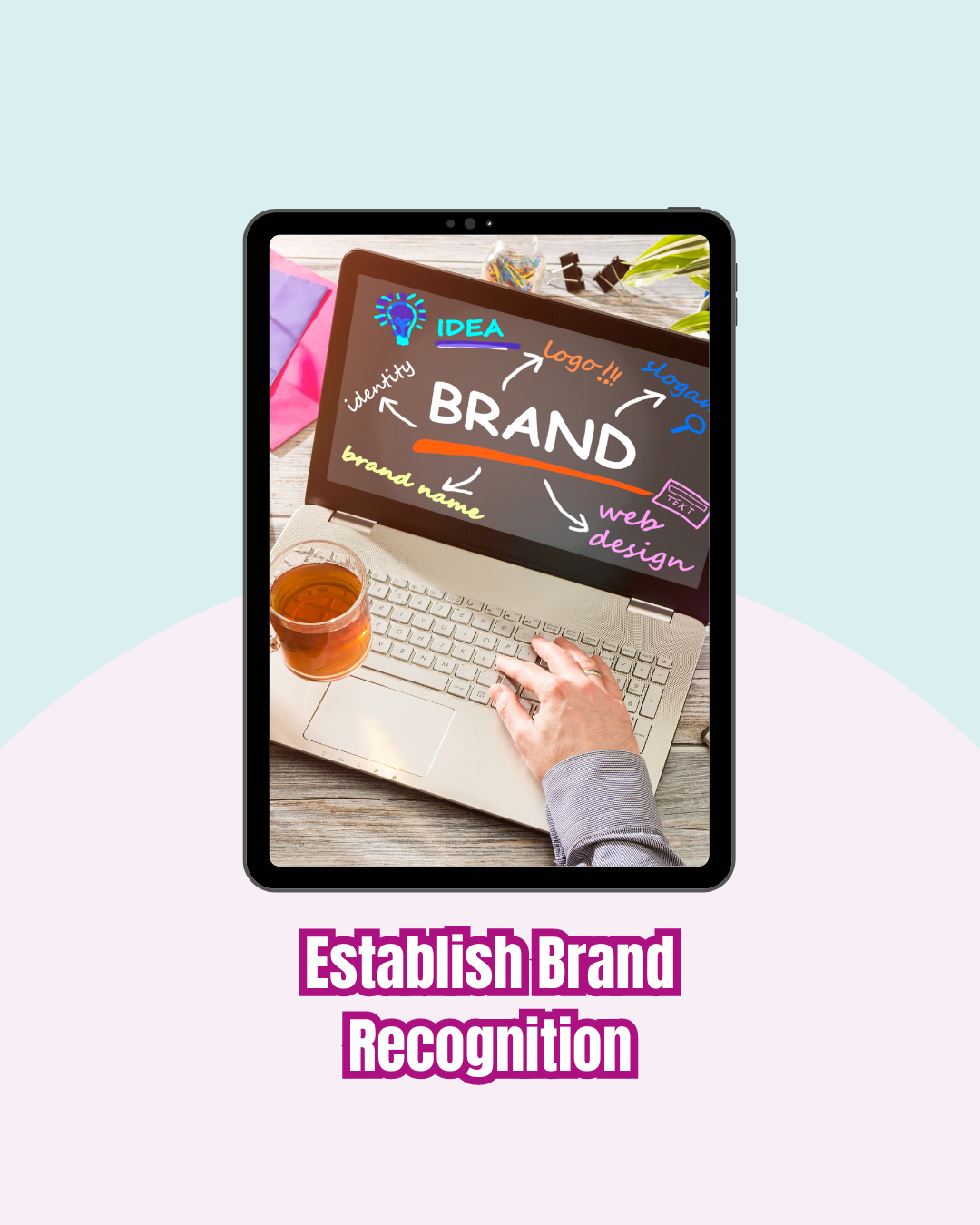
Use a consistent email template that reflects your brand's identity. This helps your subscribers instantly recognize your emails and fosters trust and familiarity.
Establishing brand recognition is a fundamental goal for any successful email marketing campaign.
One of the most effective ways to achieve this is by using a consistent email template that reflects your brand's identity. Your email template serves as a visual representation of your brand, and it should be designed in a way that aligns with
your brand's colors, fonts, and overall aesthetic.
When your subscribers consistently receive emails with a familiar look and feel, it becomes easier for them to instantly recognize your brand in their crowded inbox.
This consistency fosters trust and familiarity, as subscribers begin to associate your brand with the quality and value you provide.
Additionally, a cohesive email template helps to reinforce your brand's message and values.
Whether you are promoting a new product, sharing valuable content, or announcing a special offer, your email template sets the stage for how your message is received.
To further enhance brand recognition,
consider incorporating your logo into the email template, using your brand's tagline or voice in the email copy, and including a signature color scheme that is unique to your brand.
Remember that consistency is key.
By using the same email template for all your campaigns, you create a seamless brand experience across various touchpoints, including social media, your website, and offline marketing efforts.
In conclusion, using a consistent email template that reflects your brand's identity is a powerful tool for establishing brand recognition. It helps your subscribers easily identify your emails, builds trust and familiarity,
and reinforces your brand's message and values. By investing in a cohesive email template, you pave the way for a stronger and more memorable brand presence in the minds of your audience.

Enhance the visual appeal of your emails with attention-grabbing images, videos, or infographics that complement your content and reinforce your message.
In the dynamic world of email marketing, attention-grabbing visuals play a pivotal
role in capturing your audience's interest and boosting engagement. Incorporating captivating images, videos, or infographics can take your email campaigns to the next level.
First impressions matter,
and compelling visuals are an excellent way to make a lasting one. Consider using eye-catching images that resonate with your brand and content. High-quality product images, lifestyle shots, or visually stunning
graphics can instantly pique your subscribers' curiosity.
Videos have become a powerful storytelling tool in email marketing. Including short, engaging videos can effectively communicate your message and leave a lasting impact on your audience.
Whether it's a product demo, behind-the-scenes footage, or a captivating brand story, videos can enhance your email's visual appeal and drive higher click-through rates.
Infographics are an effective way to present
complex information in a visually appealing and easily digestible format. By incorporating relevant infographics, you can present data, statistics, or step-by-step guides in a compelling and organized manner, increasing the chances of your
audience absorbing and retaining the information.
However, it's essential to strike a balance and not overload your email with visuals. Aim for a clean and aesthetically pleasing design that complements your content without
overwhelming your subscribers. Ensure that your visuals are relevant to your message and directly support your call-to-action.
In conclusion, attention-grabbing visuals are an integral part of successful email marketing campaigns.
They enhance the visual appeal of your emails, make a powerful first impression, and reinforce your message. By using compelling images, videos, or infographics, you can create a captivating email experience that
resonates with your audience and drives higher engagement rates.
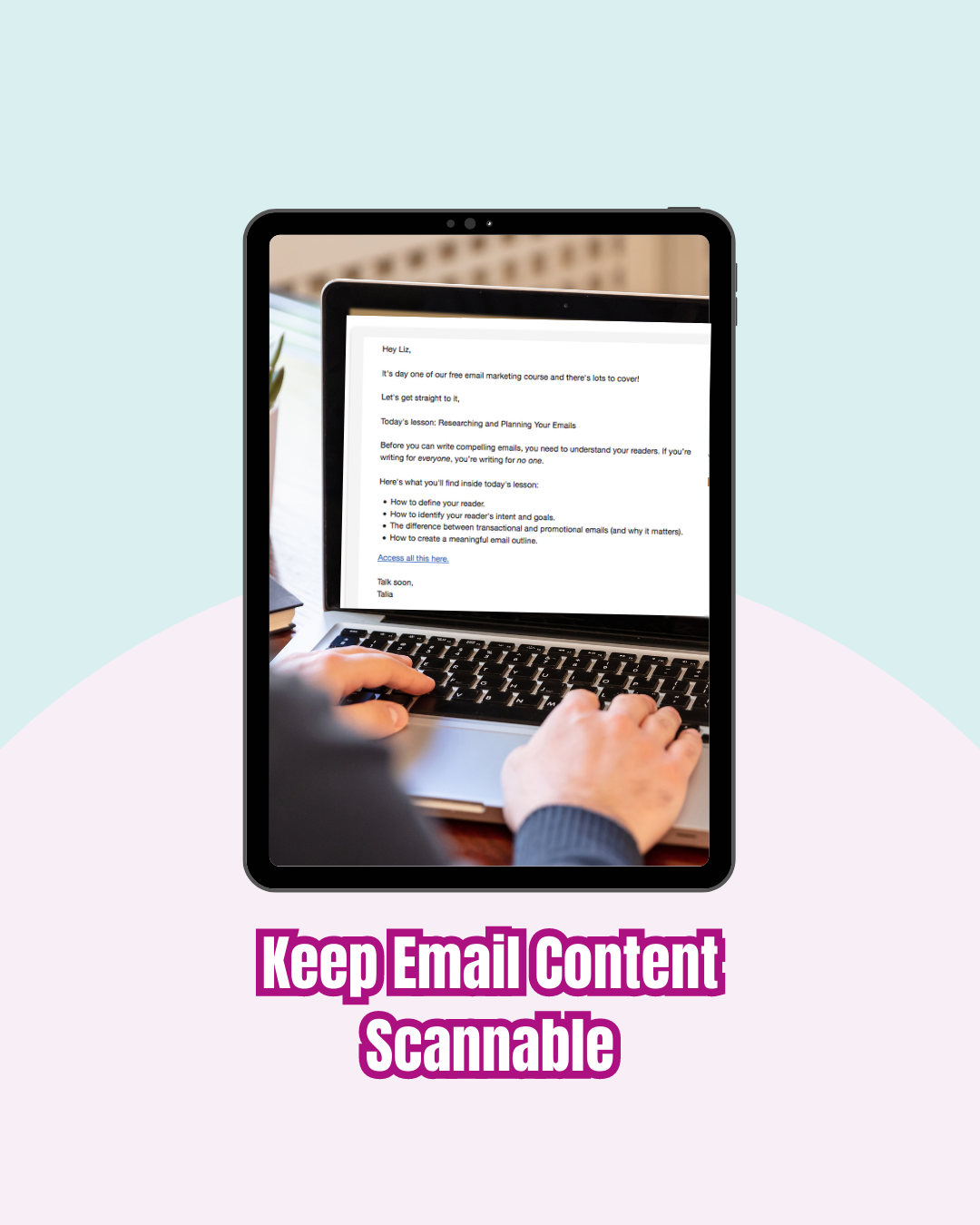
Present your email content in a scannable format with concise paragraphs, bullet points, and headings to make it easy for recipients to digest the information.
In today's fast-paced digital world,
capturing your audience's attention quickly is crucial in email marketing. To ensure your message is easily consumed, it's essential to keep your email content scannable. Presenting your content in a
scannable format allows recipients to quickly grasp the main points without having to read every word.
One effective way to achieve this is by using concise paragraphs. Avoid lengthy blocks of text that can overwhelm readers.
Instead, break down your content into short paragraphs that deliver the key information succinctly.
Bullet points are another valuable tool to make your email content scannable.
They allow you to list important points or features in a visually appealing and easy-to-digest format. Bullet points help to organize information, making it accessible at a glance.
Headings are vital signposts in your email.
They serve as clear indicators of the content that follows, guiding readers through your message. Utilize descriptive headings that accurately represent the content beneath, ensuring readers can quickly
find what they're looking for. Moreover, use bold or italicized fonts to emphasize critical details, such as offers, deadlines, or calls to action. This visual distinction draws attention to the most crucial
elements, ensuring they don't go unnoticed. By presenting your email content in a scannable format, you respect your recipients' time and attention. With the ability to quickly scan and comprehend your
message, they are more likely to engage with your content and take the desired action. So, embrace scannable content and make your emails more accessible and appealing to your audience.
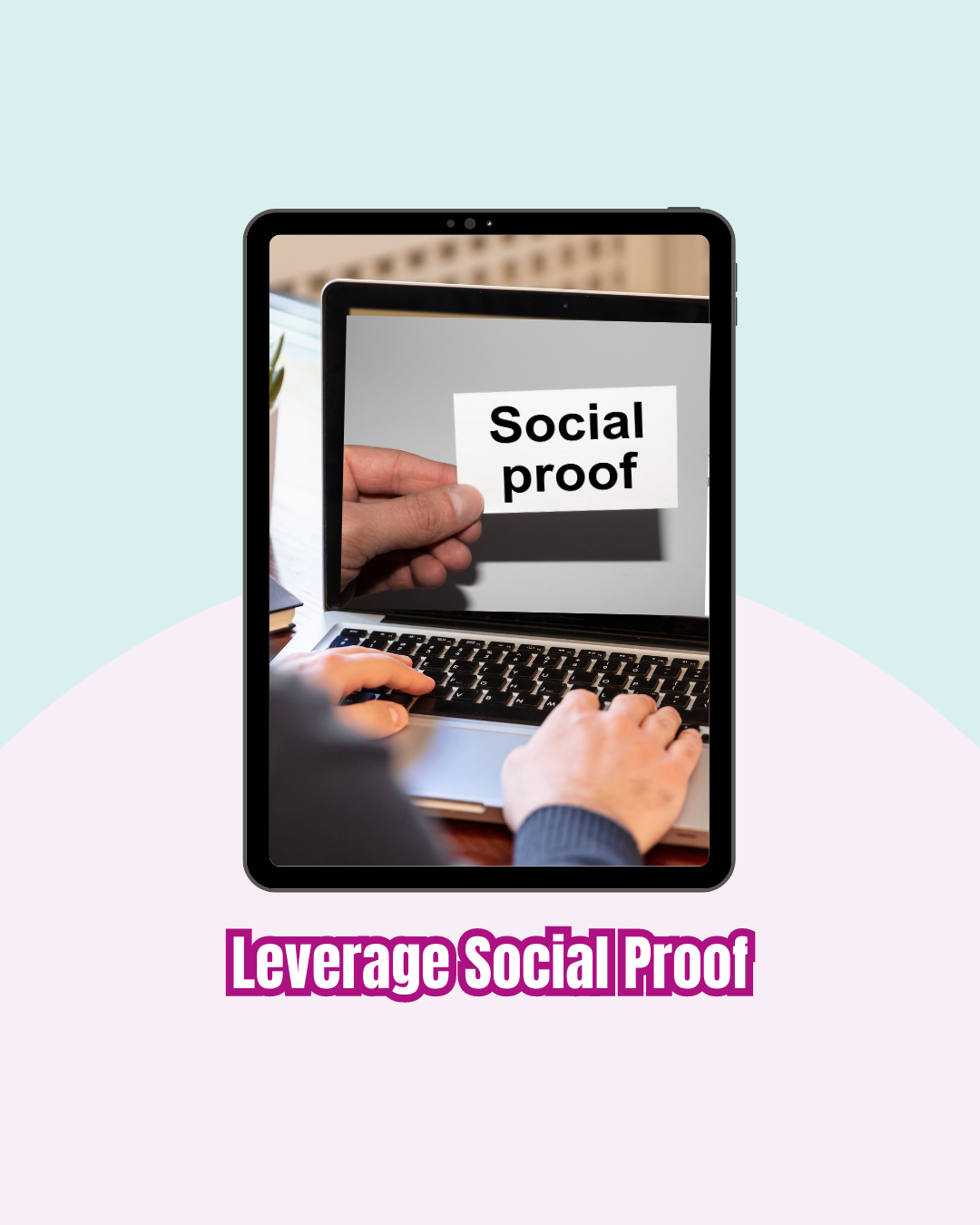
Include customer reviews, testimonials, or user-generated content to showcase social proof and increase your brand's credibility.
In the realm of digital marketing, social proof has emerged as a powerful tool to establish trust and credibility.
To enhance your brand's reputation and influence, leverage social proof in your email marketing campaigns. Incorporate customer reviews, testimonials, or user-generated content to showcase real-life experiences and interactions with your brand.
as a unique member of your community, not just another email address on your list.
But personalization goes beyond just using a name. Tailoring the content to match your subscribers' preferences and interests makes them
potential customers and helps them make informed decisions, increasing the likelihood of conversion.
User-generated content (UGC) is another invaluable resource. When customers share their
experiences through photos, videos, or stories, it creates an emotional connection with your brand. Including UGC in your emails not only promotes authenticity but also encourages engagement and brand loyalty.
To effectively leverage social proof, strategically place customer reviews or UGC throughout your email content. Highlight them in call-to-action sections or alongside product descriptions. Make sure they are visually appealing and stand
out to capture your recipients' attention.
Furthermore, consider segmenting your email list based on customer preferences or demographics to ensure that the social proof you showcase is relevant to each audience segment.
This personalized approach increases the impact and resonance of your social proof.
In conclusion, social proof is a compelling asset in email marketing. By showcasing customer reviews, testimonials, or user-generated
content, you reinforce your brand's credibility and authenticity. When potential customers see real people endorsing your brand, they are more likely to trust and connect with your business, ultimately leading to increased engagement and conversions.
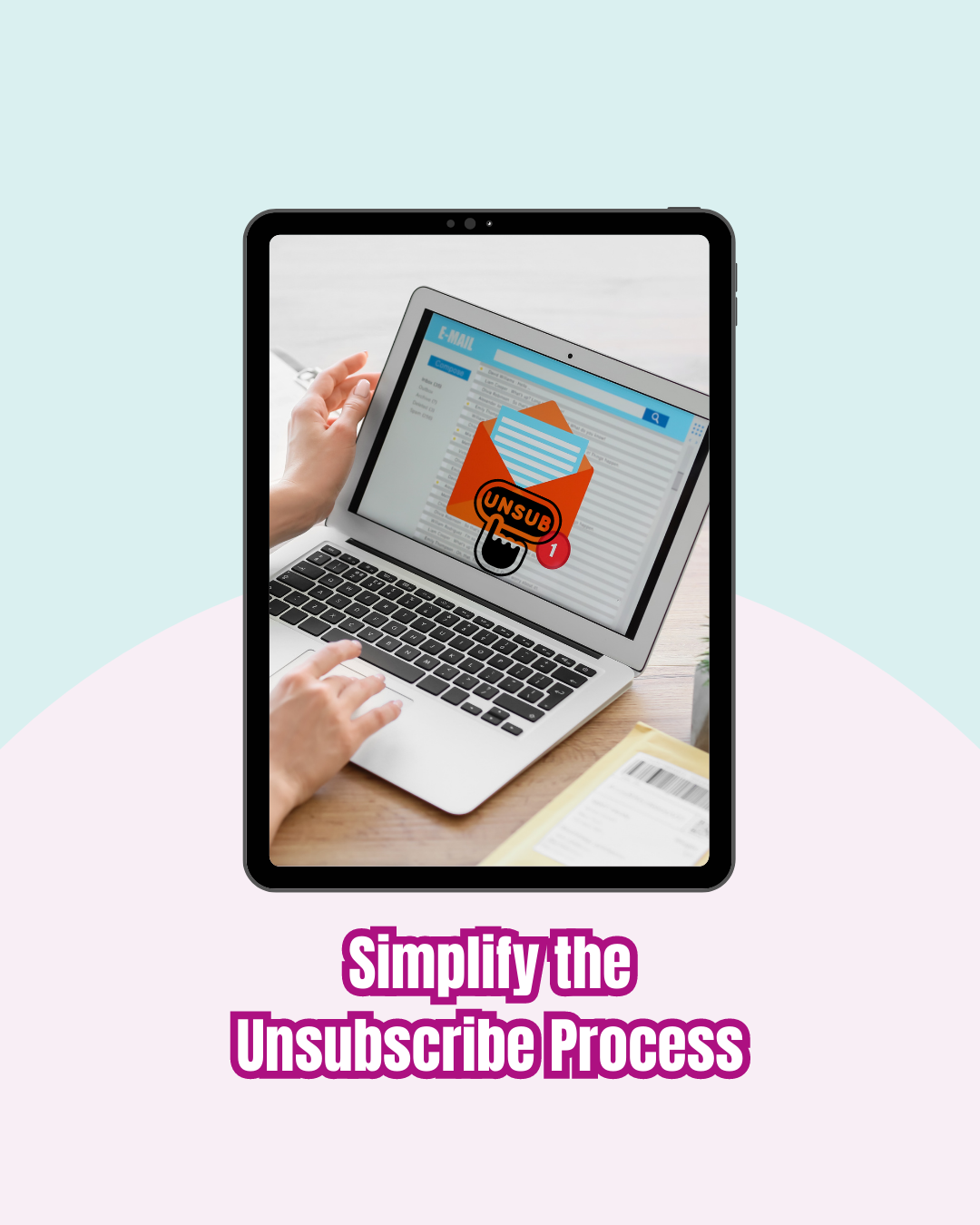
Respect your subscribers' preferences by making the unsubscribe process easy and straightforward. This ensures a positive user experience even if they decide to opt-out.
Respecting your subscribers' preferences is an essential aspect of successful email marketing. While it's natural to want to retain as many subscribers as possible, it's equally important to make the
unsubscribe process simple and straightforward. By doing so, you create a positive user experience, even for those who choose to opt-out.
An easy unsubscribe process not only demonstrates respect
for your subscribers' choices but also helps maintain a positive brand image. Complicating or hiding the unsubscribe option can lead to frustration and potentially tarnish your reputation.
Instead, provide a prominent and clear "unsubscribe" link in every email, ensuring it's easily accessible.
Moreover, when a subscriber opts to unsubscribe, honor their request promptly.
Avoid sending additional emails once they've indicated their preference to discontinue communication. By promptly respecting their decision, you leave a positive last impression, leaving the door open for them to return in the future if they wish.
As part of your email marketing strategy, it's crucial to analyze your unsubscribe data periodically. Understanding the reasons why subscribers are opting out can provide valuable insights into potential areas for improvement.
Use this information to refine your email content and frequency to better align with your audience's preferences.
In conclusion, a simplified unsubscribe process is a sign of a respectful and
customer-centric approach to email marketing. By making it easy for subscribers to opt-out, you enhance the overall user experience and reinforce your brand's positive reputation. Remember, prioritizing your
subscribers' preferences and needs fosters trust and loyalty, which are vital in maintaining a successful and engaged email community.
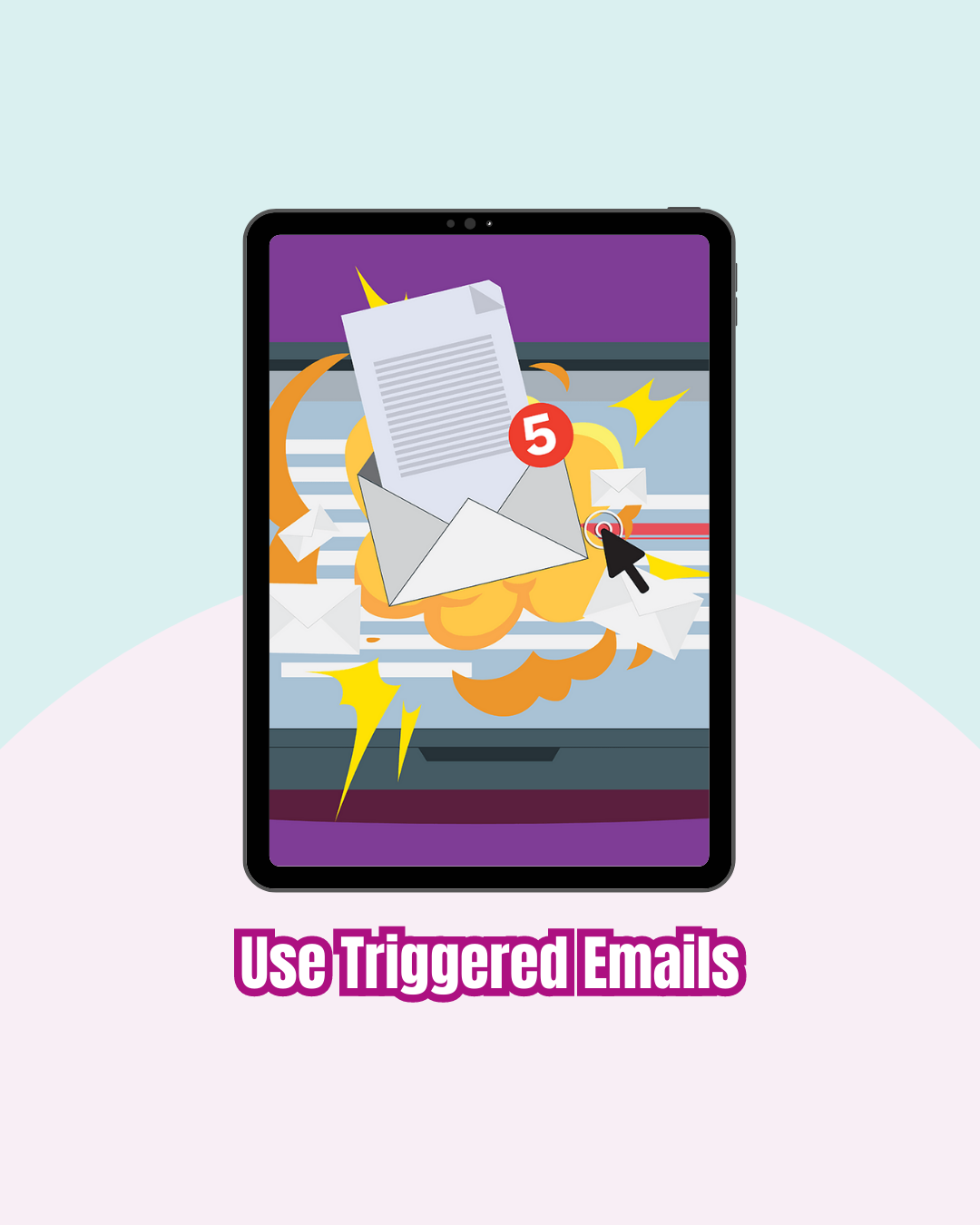
Leverage triggered emails, such as abandoned cart reminders, to re-engage potential customers and drive conversions.
Triggered emails are a powerful tool in email marketing that can significantly boost
engagement and conversions. By leveraging triggered emails, such as abandoned cart reminders, you have the opportunity to re-engage potential customers and nudge them towards completing their purchase.
Abandoned cart reminders are one of the most effective types of triggered emails. When a customer adds items to their cart but doesn't complete the purchase, an automated email can be sent to remind
them of their pending purchase. This gentle reminder can be the push they need to return to your website and finalize their order.
In addition to abandoned cart reminders, other triggered emails can
be utilized based on specific actions or behaviors. For example, welcome emails can be sent to new subscribers to greet and introduce them to your brand, while transactional emails can confirm purchases and
provide order details. The beauty of triggered emails lies in their timeliness and relevance. They are sent in response to a specific action, making them highly personalized and engaging for the
recipient. This level of customization fosters a deeper connection with your audience and increases the likelihood of driving conversions. To make the most of triggered emails, ensure that your email automation is set up correctly and
that your content aligns with the recipient's behavior. For example, abandoned cart reminders should include the items left in the cart, a clear call-to-action, and possibly an incentive
like a discount to encourage completion. In conclusion, triggered emails are a valuable addition to any email marketing strategy. By using them strategically, such as through abandoned
cart reminders, you can re-engage potential customers, drive conversions, and create a more personalized and effective email experience for your audience.
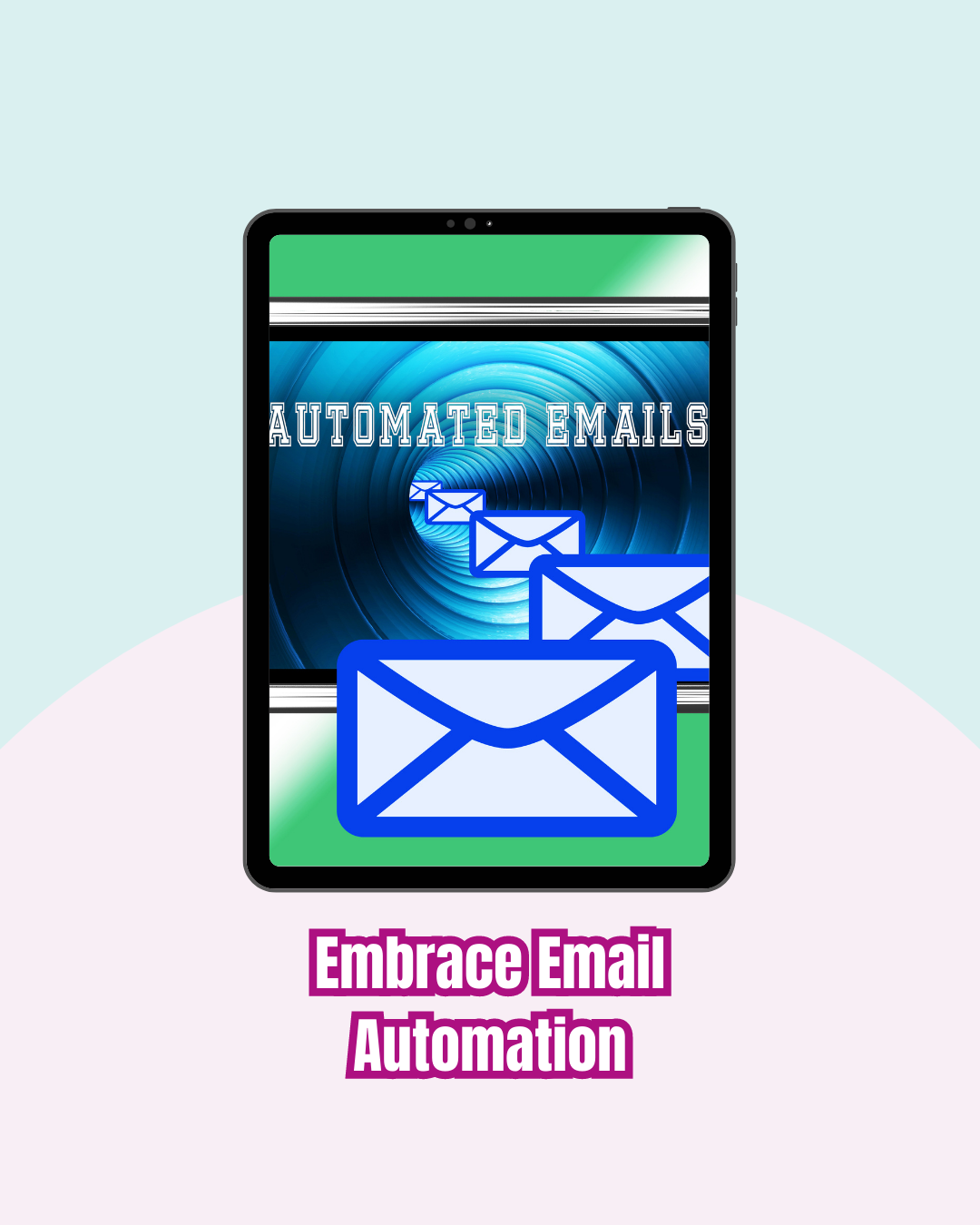
Save time and increase efficiency by using email automation for welcome emails, drip campaigns, and follow-ups.
In the fast-paced world of email marketing, embracing email automation is a
game-changer. By automating repetitive tasks, you can save time, increase efficiency, and create a more personalized and streamlined email experience for your audience. Welcome emails are the first touchpoint with your new subscribers,
and automating them ensures that every new sign-up receives a warm greeting and introduction to your brand. This sets the stage for a positive customer journey right from the start. Drip campaigns are another powerful
application of email automation. They allow you to send a series of pre-planned emails over a specific time period, nurturing leads and guiding them through the sales funnel. With automation, you can send timely
and relevant content without manual intervention, providing a consistent and cohesive messaging strategy.
Follow-up emails are essential for customer engagement and retention.
Whether it's after a purchase, event attendance, or other interactions, automating follow-ups ensures that you stay connected with your audience and reinforce your brand's relationship with them.
To make the most of email automation, segment your email list based on user preferences and behavior. This enables you to tailor your automated emails to each group, delivering more relevant and personalized content.
Additionally, use analytics to monitor the performance of your automated emails and make data-driven improvements to optimize their effectiveness.
In conclusion, email automation is a powerful tool for any
email marketing strategy. By utilizing automation for welcome emails, drip campaigns, and follow-ups, you can save time, enhance efficiency, and deliver a more engaging and tailored email experience to your audience.
Embrace email automation, and watch your email marketing efforts soar to new heights of success.

Regularly test email deliverability to ensure your messages are reaching subscribers' inboxes and not being marked as spam.
Testing email deliverability is a crucial step in ensuring the success of your email marketing campaigns.
It involves regularly checking whether your emails are reaching subscribers' inboxes and not getting flagged as spam. Deliverability issues can significantly impact your email engagement and conversion rates,
so staying proactive in this area is essential.
To test email deliverability, you can use various tools and techniques. One method is to conduct inbox placement tests, where you send test emails to different email providers to assess
how they handle your messages. This helps you identify any potential deliverability issues and allows you to make necessary adjustments.
Monitoring your email sender reputation is equally important. Your sender
reputation plays a significant role in determining whether your emails are delivered successfully. High spam complaints or low engagement rates can negatively impact your reputation, leading to
deliverability problems. Regularly review your email analytics and address any issues that may arise promptly.
Another useful practice is to maintain a clean and engaged email list. Remove inactive or
disengaged subscribers to improve deliverability and avoid sending emails to invalid or uninterested addresses.
Lastly, authenticate your email domain with SPF, DKIM, and DMARC records.
These authentication protocols help ensure that your emails are recognized as legitimate and not spoofed, reducing the chances of them being marked as spam. In conclusion, regularly testing email
deliverability is a crucial part of a successful email marketing strategy. By staying proactive in monitoring inbox placement, sender reputation, and list hygiene, you can ensure that your messages reach your
audience's inboxes and maximize the effectiveness of your email campaigns. Protect your sender reputation, deliver valuable content, and maintain an engaged email list to achieve optimal deliverability and drive better results.
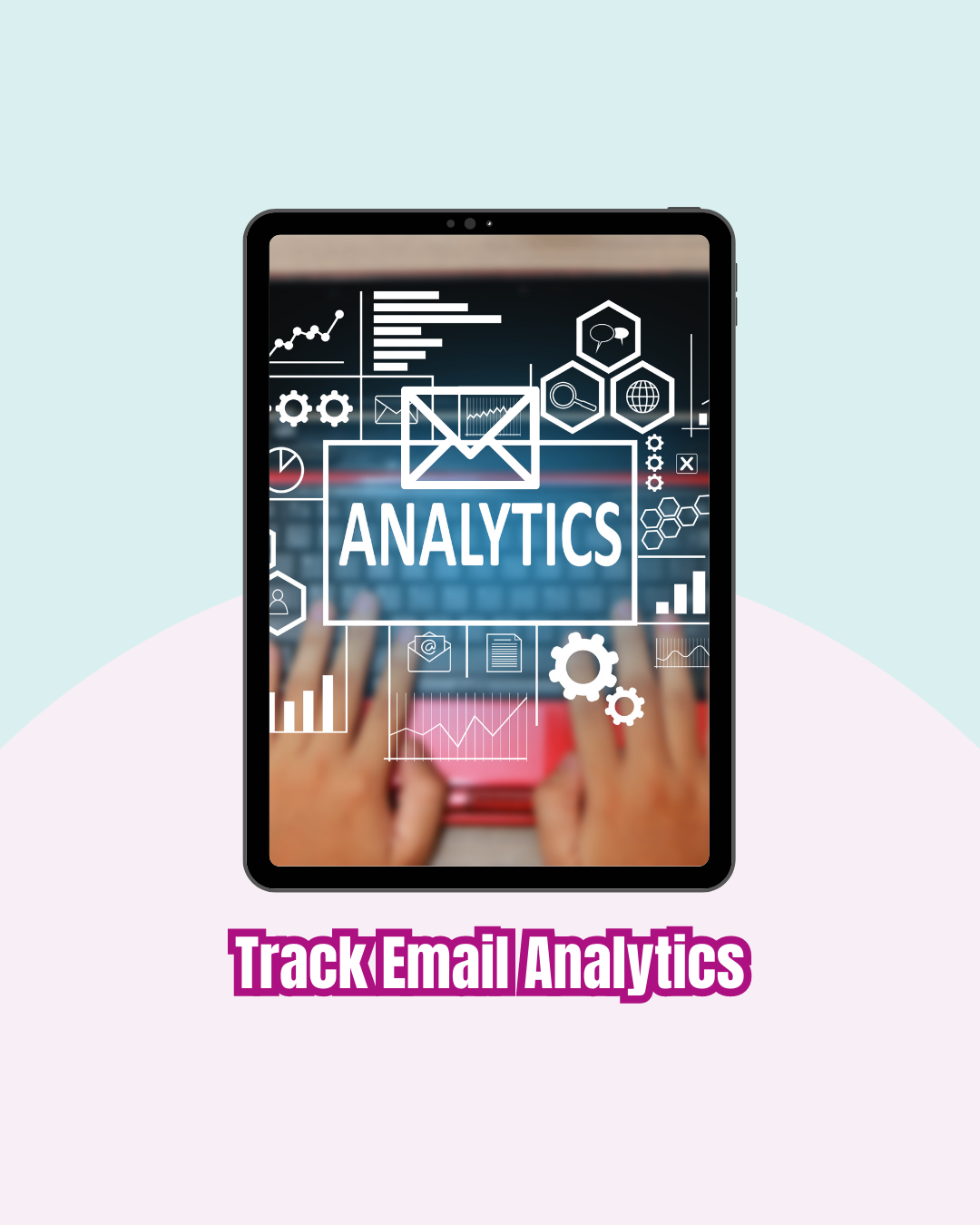
Use email analytics to measure the success of your campaigns, analyze performance metrics, and identify areas for improvement.
Email analytics is a powerful tool that provides valuable insights into the effectiveness of your email marketing campaigns.
By tracking email analytics, you can measure various performance metrics and gain a deeper understanding of your audience's behavior and preferences.
One of the key metrics to track is the open rate, which indicates
how many recipients opened your email. It helps you gauge the success of your subject lines and overall email engagement. Click-through rate is another crucial metric that measures the percentage of recipients who clicked
on links within your email, providing insights into the effectiveness of your content and calls-to-action.
Analyzing the conversion rate allows you to assess how many recipients took the desired action,
such as making a purchase or signing up for an event, after clicking through your email. This metric is a direct indicator of your campaign's success in driving valuable actions. Furthermore, tracking email bounce rates helps you identify and remove
invalid or inactive email addresses from your list, ensuring better deliverability and a cleaner email database.
By regularly reviewing email analytics, you can identify trends, understand what resonates with your audience,
and pinpoint areas for improvement. For example, if you notice low engagement on certain topics or email types, you can adjust your content strategy accordingly. A/B testing is an excellent way to leverage email analytics effectively.
By comparing different variations of your emails, you can determine what works best and refine your campaigns based on data-driven decisions.
In conclusion, tracking email analytics is a fundamental aspect of successful email marketing.
It empowers you to measure campaign success, analyze performance metrics, and make informed decisions to improve your email marketing strategy continually. Utilize the valuable insights provided by email analytics
o better understand your audience, optimize your content, and achieve better results in your email campaigns.

Keep your email content relevant and valuable to your subscribers. Provide useful information, exclusive offers, and relevant updates to keep them engaged.
In the competitive landscape of email marketing, providing relevant and valuable
content is the key to building a strong and engaged email community. Your subscribers have entrusted you with their inbox, and it's crucial to deliver content that truly matters to them. Start by understanding
your audience's interests and preferences. Segment your email list based on demographics, behavior, or past interactions to ensure that each group receives content tailored to their needs. Personalization goes a long way in
capturing your subscribers' attention and fostering a sense of connection with your brand.
Offer useful information that educates, entertains, or solves problems for your subscribers. Share valuable tips, industry insights,
or how-to guides that showcase your expertise and provide tangible benefits to your audience.
Exclusive offers and promotions are excellent incentives to keep your subscribers engaged. Providing access to special deals
or early access to new products or services creates a sense of exclusivity, making your subscribers feel valued and appreciated.
Moreover, keep your subscribers informed with relevant updates. Whether it's company news, product launches,
or event invitations, sharing timely information keeps your audience in the loop and encourages them to stay connected.
Remember that quality content is more important than quantity. Avoid bombarding your subscribers with
excessive emails, as this may lead to disengagement or unsubscribes. Instead, focus on delivering consistent, valuable content that keeps your audience eagerly anticipating your next email. In conclusion, providing relevant
and valuable content is the cornerstone of successful email marketing. By understanding your audience, personalizing your content, and offering useful information and exclusive offers, you foster a loyal
and engaged email community. Delivering content that resonates with your subscribers ultimately leads to higher open rates, increased engagement, and a positive brand perception.
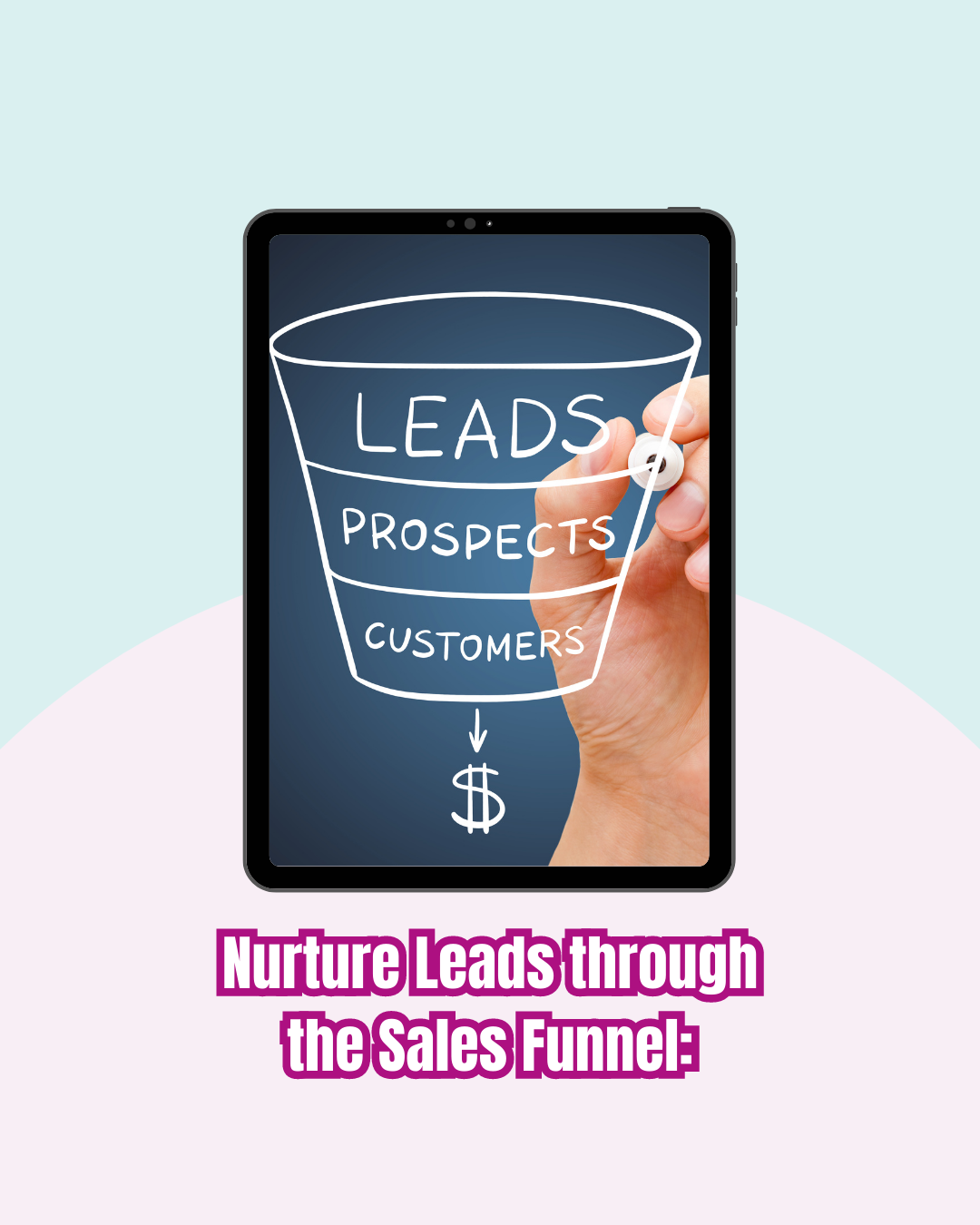
Guide leads through the sales funnel with targeted and personalized content that aligns with their journey.
In the world of sales and marketing, nurturing leads through the sales funnel is a critical
process for converting potential customers into loyal advocates. To achieve this, it's essential to provide targeted and personalized content that aligns with each lead's unique journey. The sales funnel represents the various stages a lead goes
through on their path to becoming a customer. By understanding where a lead stands in the funnel, you can tailor your content to address their specific needs and interests. At the top of the funnel, where leads are in the awareness
stage, focus on providing educational and informative content that introduces your brand and offers value without being overly promotional. Blog posts, infographics, and how-to guides can be effective tools to engage and build trust.
As leads move down the funnel into the consideration stage, they are actively seeking solutions to their problems. Provide them with detailed product information, case studies, and comparison content to showcase the benefits of
your offerings and demonstrate how you can meet their needs.
Finally, at the bottom of the funnel, where leads are ready to make a purchase decision, offer targeted incentives, testimonials, and limited-time promotions to encourage them to
take the final step. To effectively nurture leads, leverage marketing automation tools to deliver personalized content based on lead behavior and preferences. Segment your email list to ensure that each lead receives
content that aligns with their stage in the sales funnel and their specific interests.
By nurturing leads through the sales funnel with targeted and personalized content, you create a seamless and valuable customer experience.
As leads feel understood and supported throughout their journey, they are more likely to convert into satisfied customers and continue their relationship with your brand.

Analyze data, track results, and make data-driven adjustments to continuously improve your email marketing strategy.
In the ever-evolving landscape of email marketing, the key to staying ahead of the competition is continuous
improvement. To achieve this, it's essential to analyze data, track results, and make data-driven adjustments to your email marketing strategy. Regularly review email analytics to understand the performance of your campaigns.
Pay attention to key metrics such as open rates, click-through rates, conversion rates, and unsubscribe rates. Analyzing this data provides valuable insights into what is working well and what areas need improvement.
A/B testing is a powerful tool to optimize your email strategy. Test different elements of your emails, such as subject lines, CTAs, visuals, and content, to determine which variations yield the best results. Use the insights gained from
these tests to refine your approach and implement changes that drive better engagement and conversions.
Additionally, pay attention to audience feedback and preferences. Encourage subscribers to provide feedback through surveys or direct
communication. Listening to your audience's needs and preferences helps you better tailor your content and offerings to meet their expectations.
Stay updated on the latest email marketing trends and best practices.
The digital landscape is continually evolving, and staying informed about new technologies, consumer behavior, and industry benchmarks can give you a competitive edge.
Finally, don't be afraid to experiment and try new approaches.
Innovation is essential to keep your email marketing strategy fresh and engaging. Continuously improving your strategy based on data and insights ensures that you adapt to changing market conditions and maintain a strong connection with your audience.
n conclusion, continuous improvement is a fundamental aspect of successful email marketing. By analyzing data, conducting A/B tests, listening to your audience, and staying updated on industry trends, you can refine
your strategy and optimize your email campaigns for better results. Embrace a data-driven approach and remain adaptable to achieve long
Conclusion:
By following these 20 tips for email marketing success, you can create effective and engaging email campaigns that resonate with your audience, drive conversions, and ultimately contribute to the growth of your business. Remember to continuously monitor your performance, experiment with new tactics, and always prioritize providing value to your subscribers. Email marketing remains a powerful tool in your marketing arsenal when implemented strategically and with a customer-centric approach.
Check out the free products and resources available to you.
Leave a reply

Let’s Collaborate To Grow
Your Dream Results Are Closer Than You Think.
Ready to take the next step? Book a free chat, and let's discuss how we can work together to achieve your goals. In the meantime, please complete the "Collaboration Interest Form" so we can create a collaboration that aligns with your interests.
Remember, building a successful business doesn't have to be a solo journey. At nuBeginning, we're committed to providing you with the tools, resources, and support you need to turn your entrepreneurial dreams into reality.
Useful Links
Copyright © 2022 SuePats.com - nuBeginning.com | All Rights Reserved | PRIVACY POLICY - TERMS & CONDITIONS - DISCLAIMER












